The assault on “little Stalingrad” and the creation of the Sivash bridgehead
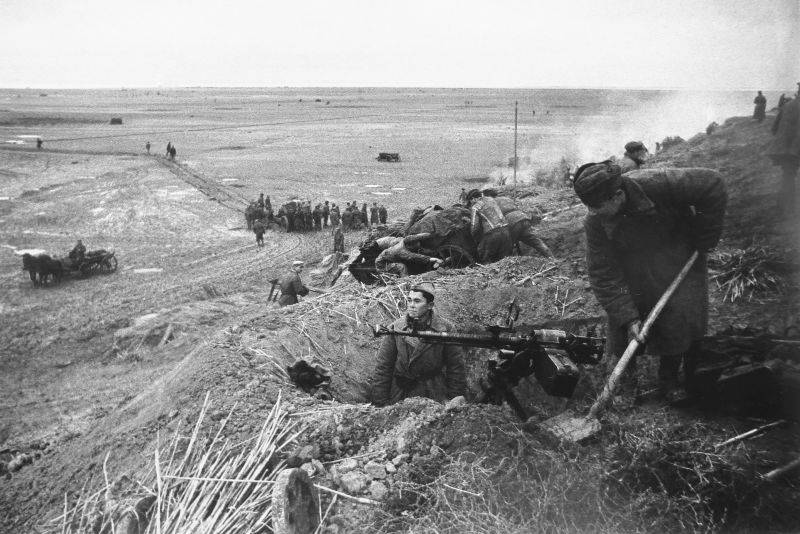
Soviet soldiers on the shore of Lake Sivash. Red Army soldiers in the foreground are setting up a position for a 12,7 mm DShK machine gun. November 1943
The first assault on the Wotan Line failed
On September 26, 1943, the troops of the Southern Front (from October 20 - 4th Ukrainian) under the command of Fyodor Tolbukhin began the Melitopol operation with the goal of defeating the German 6th Field Army from Army Group "A", liberating Northern Tavria, access to the lower reaches of the Dnieper and to Crimea.
The Southern Front included the 5th Shock, 2nd Guards, 44th, 28th, 51st, 8th Air Armies, 11th, 19th, 20th tank corps, 2nd and 4th Guards Mechanized Corps, 4th and 5th Guards Cavalry Corps. A total of 575 thousand people, up to 800 tanks and self-propelled guns, more than 5 guns and mortars, more than 600 aircraft.
The German Melitopol group numbered more than 200 thousand people, about 1 guns and mortars, 500 tanks. It was supported by up to 150 combat aircraft. The Nazis defended themselves on the “Wotan Line” - a section of the so-called. "Eastern Wall" along the Molochnaya River. The “Wotan Line” covered Nikopol, the railway running through Melitopol - the main supply line of the Crimean group.
The southern flank of the German army adjoined a swampy estuary, through which it would have been suicide to attack. In the south, the 6th Army had connections with the Crimean group, in the north - with the Zaporozhye group of the Wehrmacht. It was necessary to storm the powerful line of defense head-on, where, according to the chief of staff of the Southern Front, future Marshal Sergei Biryuzov, every village was turned into a fortress:
During the SF offensive, it was planned to deliver two strikes: the main strike with the main forces - north of Melitopol (4 armies, 4 mobile corps), and an auxiliary strike - with the forces of the 28th Army, from the area south of Melitopol, bypassing the city from the southwest.
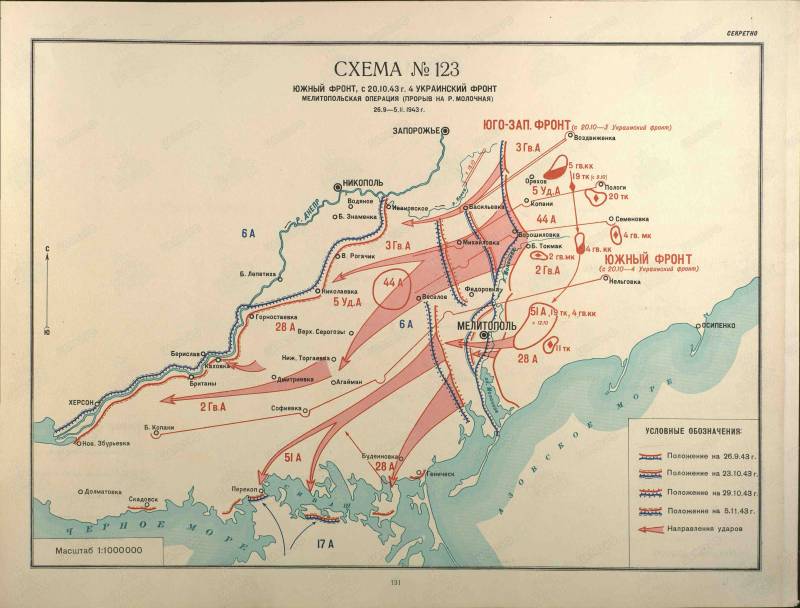
Marshal Vasilevsky, who held the positions of Chief of the General Staff and Deputy People's Commissar of Defense, sent an optimistic report to Headquarters on the evening of September 22. He believed that the German army had already been defeated; it was only necessary to quickly clear the Lower Dnieper of the enemy, cross the Dnieper, and reach Perekop and Kherson. Therefore, two mobile strike groups (tank, mechanized and two cavalry corps), which were planned to be introduced into the breakthrough, were called “Hurricane” and “Storm”. Front troops were given 4 days to prepare the offensive, 2 days to break through, and 11–12 days to develop success, with infantry advancing 15–16 kilometers per day and mobile groups 30.
However, the Germans did not know that they had already been defeated. The armies of the Southern Front advanced practically without a pause, without appropriate preparation, reconnaissance, without bringing up the rear and without replenishing depleted reserves. Exhausted and bloodless in the battles for Donbass, the troops of the Southern Front attacked German positions head-on on September 26, 1943 and suffered heavy losses.
– recalled artilleryman Semyon Shtipelman.
German ground forces were actively supported aviation. In 5 days of bloody fighting, Soviet troops managed to penetrate the enemy’s defenses by only 2–5 km. On September 30, the fruitless offensive was stopped.
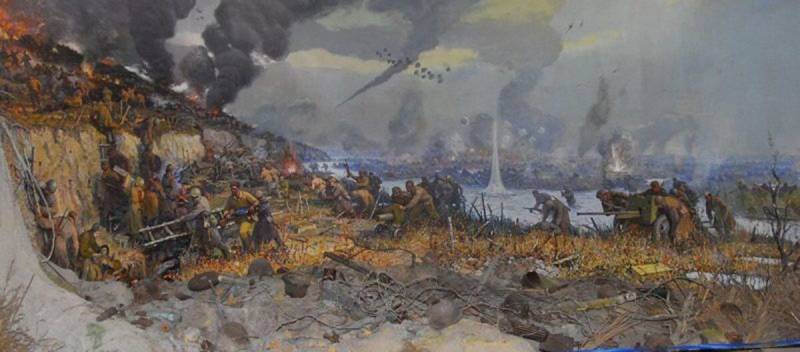
Assault on the “Wotan Line” on the Molochnaya River. Diorama fragment
"Little Stalingrad"
Normal preparations were made for the next attack. Reconnaissance of enemy positions. They pulled up the rear and stockpiled ammunition. The troops were regrouped. We established cooperation with the Southwestern Front, which was advancing in the Zaporozhye direction. It turned out that the Germans were transferring reinforcements from the southern flank to the northern.
The command of the Southern Fleet regrouped the main forces in the opposite direction: they began to transfer troops of the 28st Army, tank and cavalry corps to the zone of the 51th Army, which made it possible to achieve a noticeable advantage on the southern wing.
As a result of the liberation of Zaporozhye, one of the main strongholds of the Wehrmacht on the Lower Dnieper (Assault on the Zaporozhye bridgehead), the situation in southern Ukraine changed noticeably in favor of the Red Army. The troops of the German 6th Field Army defending on the Molochnaya River, closing the approaches to the Crimea and the lower reaches of the Dnieper, found themselves in a dangerous position. The left flank of the 6th Army was open.
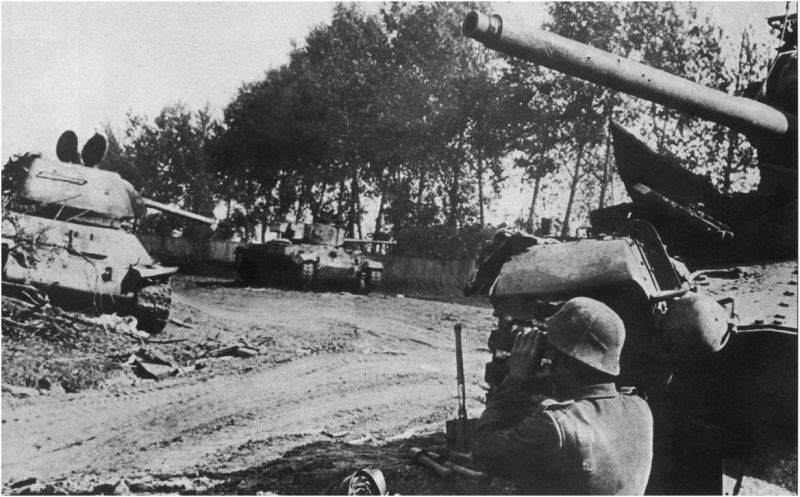
Soviet T-34 and Valentine IX tanks, knocked out and lost during the Soviet offensive on Melitopol. Vehicles from the 19th Tank Corps of the Southern Front. A position of German soldiers was set up under the cover of a nearby tank. September-October 1943
On October 9, after a 45-minute artillery barrage, the second assault on the enemy line of defense began. This time the artillery worked well, targeting reconnoitered targets. Enemy fire positions were largely suppressed. The next day, our troops broke through to the southern outskirts of Melitopol. The success of Gerasimenko's 28th Army predetermined the victory of the entire front. The 51st Army of the Cruiser was aimed at the assault on Melitopol.
The fighting for the city was extremely fierce. The German command understood that its loss would lead the Russians to the lower reaches of the Dnieper, to Kherson, Nikolaev and Odessa, to Perekop. To hold the “Wotan Line” from Crimea and the Taman Peninsula, from where the 17th Army was evacuated (Evacuation of the German 17th Army from Taman), transferred up to 9 divisions.
The Germans fought fiercely. Therefore, Melitopol was called “little Stalingrad”.
Assault groups were used. A special role in the assault on the city was played by the 12th Assault Engineer Brigade, the “armor soldiers”, clearly recognizable by their steel breastplates (the prototype of modern body armor). True, brigade commander Pyotr Panchevsky noted that after the first battles, his subordinates began to massively remove heavy cuirasses, which made it difficult to move quickly through the ruins of the city.
Stormtroopers-sappers were distributed among different units; a distinctive feature of their actions was the immediate transfer of minefields. Panczewski himself claimed that from October 16 to October 22, each anti-tank mine changed its laying location on average at least five times. The sappers made passages into the buildings where the Nazi units were holed up. Such “fortresses” had to be stormed.
Groups of “tank hunters” in narrow urban areas used to throw mines literally under enemy vehicles. For such work, Sergeant Nikolai Sosin received the title of Hero of the Soviet Union. He destroyed two enemy tanks personally, and two more were blown up in a minefield that was installed by his subordinates.
On October 23, enemy resistance was broken. Melitopol was liberated. The 18 most distinguished units and formations received the honorary names Melitopol. For the liberation of the city of Melitopol, 87 soldiers and commanders received the title of Hero of the Soviet Union, of which 12 soldiers were natives of Melitopol.
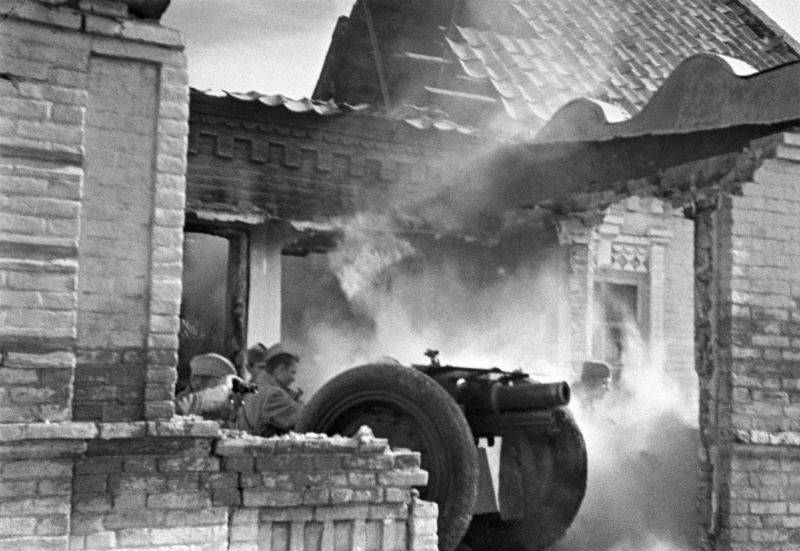
The crew of the Soviet 76-mm regimental gun of the 1927 model in the street battle for the liberation of Melitopol. October 1943
Sivash
Meanwhile, troops advancing north of the city also broke through the defenses and cut the Zaporozhye-Melitopol railway line. The Burya mobile group, consisting of the 4th Guards Kuban Cavalry and 19th Tank Corps, was brought into the breakthrough south of the city. On October 24–26, the Nazis began a general retreat.
Overcoming the resistance of the retreating enemy rearguards, the 2nd Guards Army covered the path from Molochnaya to the Dnieper in just over a month. On October 30, the 28th Army liberated Genichesk and reached the coast of Sivash Bay. The 51st Army, together with Vasiliev’s 19th Tank Corps, reached the Perekop Isthmus.
On November 1, the operation to cross Sivash began. We found the guide Vasily Zaulochny. Three scouts went with him across the Rotten Sea - guard sergeants Dmitry Mikhailov and Stepan Kudymov and guard private Nikolai Karmyshin. The guide and scouts reached the opposite bank and lit a fire. Hundreds of fighters, slowly moving up to their chests and necks in the cold November water, went to Crimea. The crossing of Sivash took place by fording. All weapon the infantry carried on themselves, including heavy machine guns, 82-mm mortars. The artillery crossing was organized on November 2–3.
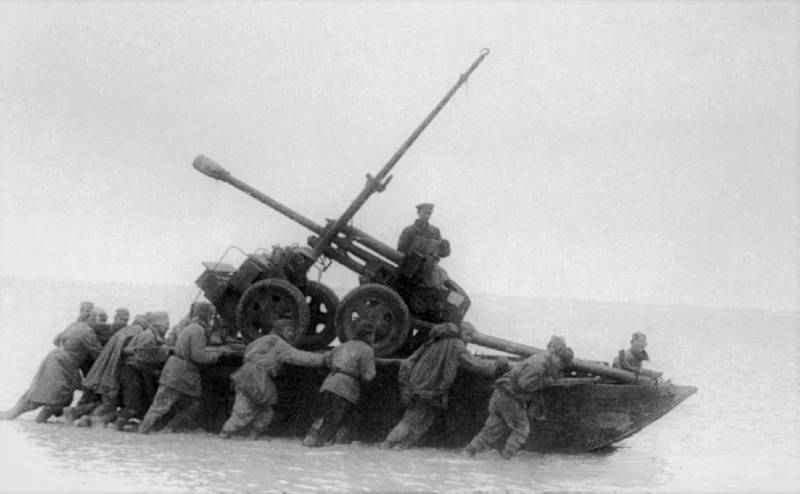
Sappers of Captain F. S. Bulatov transport artillery through Sivash. Fyodor Bulatov is the commander of the 57th separate assault engineer sapper battalion of the 12th assault engineer sapper brigade of the RGK. November 1943
The main difficulties in crossing the Sivash were that its bottom was extremely muddy and the water was at a very low temperature. Horses and carts could not ford, and the Red Army soldiers had to carry all their weapons and ammunition on themselves. There were no means for transporting artillery, equipment, or horses. The 10th Corps had no moving parts, and the rear was far behind. Supply was already carried out using aircraft.
The first to cross Sivash was the 346th Infantry Division of the 10th Corps of the 51st Army. During October 31, units of the division, pursuing the retreating enemy, reached the area: Stroganovka, Ivanovka, Novo-Nikolaevka by the end of the day. We carried out reconnaissance and at 11 o'clock on November 1 began crossing the water barrier. The overcoming of Sivash at first proceeded without enemy resistance. The coast was clear. Only at 14 p.m. did our troops discover German planes and fire at them. Soviet regiments immediately captured Biyuk Kiyat, Tomashevkau and Ashkadan-Tarkhan. They captured a platoon of Slovaks who were supposed to guard the shore.
Following the 346th division, the 216th rifle division crossed. The crossing was completed on the morning of November 2, followed by the 257th Infantry Division. Divisional artillery and combat support units of both divisions remained in the area of the village of Kosa. Artillery could only provide limited assistance to rifle units, as stated in the documents “out of range.” The 257th Division was able to transport regimental and anti-tank artillery. As stated in the division report: “The regimental artillery was transported on wooden trays by the soldiers.”
The headquarters of the German 336th Infantry Division received news of the enemy's appearance on the southern bank of the Sivash only at 23:30 on November 1. The Russians were discovered too late and could not be thrown into the water right away. Soviet regiments entrenched themselves in the occupied territory.
As a result, Soviet troops immediately seized a bridgehead on the southern bank of the Sivash, but were unable to break through further. Fighting in this area continued until April 1944, when the Red Army launched a decisive operation to liberate Crimea.
This completed the operation.
As a result of the operation, the troops of the 4th Ukrainian Front advanced to the west and southwest by 50–320 km, liberated almost all of Northern Tavria and blocked the Crimean Wehrmacht group from land, creating conditions for the liberation of Crimea and the south of Right-Bank Ukraine.
The losses of the Red Army were heavy: about 200 thousand people (irrecoverable - 43 thousand). Soviet troops defeated 8 enemy divisions and inflicted significant damage on 12 divisions.
According to Soviet data, the enemy lost over 100 thousand people.
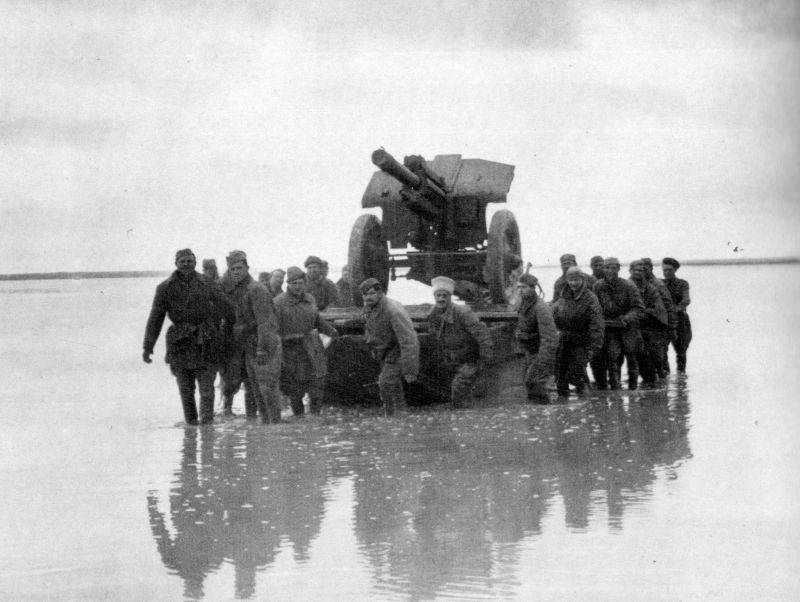
Soviet soldiers transport a 122-mm M-1938 model 30 howitzer on a pontoon across the Sivash Bay (Rotten Sea). November 1943
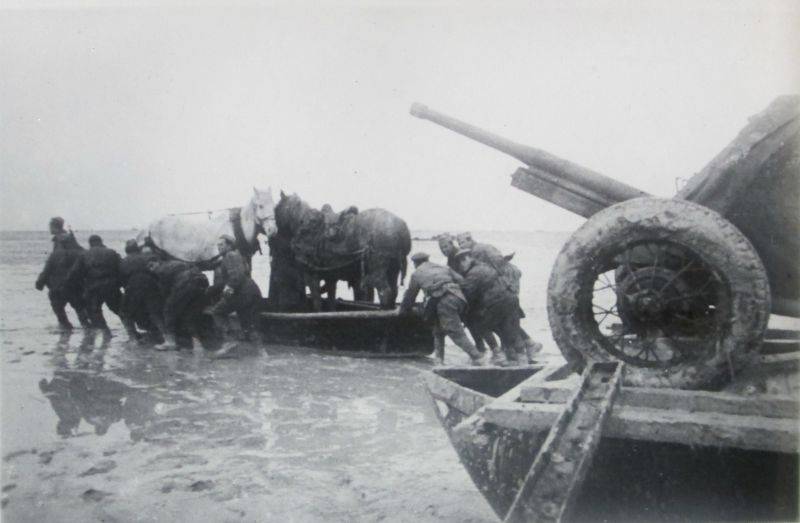
Soviet troops smuggle military equipment and horses through the Sivash. In the foreground an 45-mm anti-tank gun. December 1943
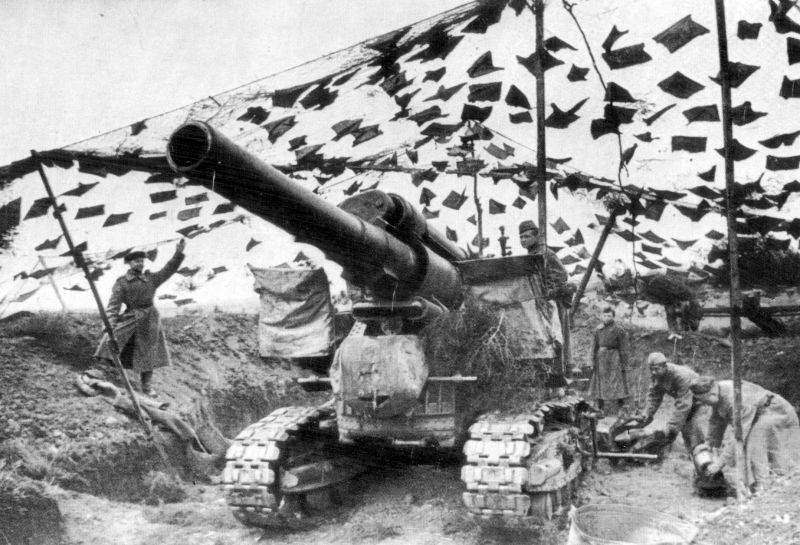
Artillerymen fire at German positions from a 203-mm howitzer model 1931 (B-4). Perekop Isthmus. The commander of the gun is Guard Sergeant Mikhail Bondarenko. 2nd battery of the 2nd division of the 20th Guards high-power howitzer artillery brigade named after. K. E. Voroshilova, 2nd Guards Artillery Breakthrough Division of the RGK, 4th Ukrainian Front. November 1943
Information